Snockgrass
by Michael Hurley
[Music CD]
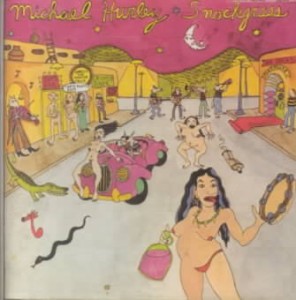
view/request
Fact: Michael Hurley (a.k.a. “Snock”) is a drastically, under-appreciated American folk singer. With a voice reminiscent of Hank Williams and a songwriting style rooted in country & western, bluegrass and the blues, Hurley has been issuing stellar material since the early 1960’s. Recent years have seen a new appreciation for the musician. Artists such as Vetiver, Lucinda Williams, Cat Power and Matloaf have cited Hurley as an influence.
1980’s Snockgrass (album not pictured here due to singer’s risque cover painting) is classic Michael Hurley. There’s plenty of swinging numbers, reflective waltzes, weirdo lyrics and country-fried boogies with the mood volleying from serious to sardonic to silly. “The Midnight Rounder”, “O My Stars” and “Watchin’ the Show” are excellent starting places for someone just beginning their Snock obsession.
Reviewed by Jason
Tagged: Blues music, Country music, Folk music
Stay Hungry
by Bob Rafelson
[DVD]
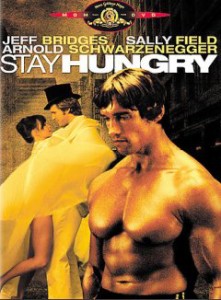
view/request
There’s just something about the “New Hollywood” films of the 1970’s… The budgets were smaller, but the films seem to resonate so much more than your typical, bloated Hollywood picture. With less resources, the directors of these movies focused on telling stories.
Bob Rafelson’s Stay Hungry tells the story of a recently orphaned grown, southern man named Craig Blake (Jeff Bridges). The opening shot is of the beautiful Blake estate and the narration of a letter read by Craig’s uncle advising his nephew to continue the family tradition and get into steel business. The younger Blake ignores his relative’s advice and teams up with a group of shady real estate sharks to buy out the businesses in a downtown building to may way for an office high-rise.
His colleagues are quickly successful in securing the property and they impatiently await Blake’s seizure of the last independent establishment, a local gym. Here Blake meets a cast of interesting characters including the beautiful, small town receptionist Mary Tate Farnsworth (Sally Field) and the zen body builder/fiddle player Joe Santo (Arnold Schwarzenegger). After visiting on several occasions trying to get the nerve to make an offer from the manic gym’s owner, Blake, a man who recently lost those close to him, finds a surrogate family with the regular gym rats and also eventually falls for Mary Tate.
The struggle to seize the gym, a conflict between the various classes of wealth depicted, an upcoming Mr. Universe pageant, the sometimes troubled romance of Craig and Mary Tate and an exceptionally strange and lengthy fight sequence, make Stay Hungry a wonderful comedy/drama piece. The principle actors all give some of the best performances of their careers and the film is full of unforgettable featured players.
Reviewed by Jason
Tagged: 1970s, Bodybuilding, Feature film
Tabloid
by Errol Morris
[DVD]
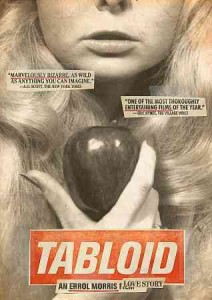
view/request
This documentary feature recalls the strange adventures Joyce McKinney, a former Wyoming beauty queen. Using interviews with the woman herself, a pilot, an ex-Mormon, a British tabloid reporter, a photographer and a scientist in the field of cloning, we learn learn the bizarre history of McKinney. While mostly relying on these talking head interviews in front of a greyish background with archival footage and cut and paste animation, Morris creates a riveting, suspenseful film.
It recalls a period in the late 1970’s when Joyce McKinney became a British tabloid star after flying to the U.K. with a small crew to “rescue” her estranged Mormon missionary boyfriend. She claims he was brainwashed by members of the church and so she took him to an inn for three days to deprogram his brain. His story differs. Kirk Anderson (who did not wish to be interviewed for the documentary) had claimed that he was kidnapped at gunpoint, tied up and then raped by McKinney. After the news broke, tabloid papers looked into the beauty queen’s history and produced several scandalous pieces.
While viewing
Tabloid, a particular scene from the film
Head seemed rather poignant. The Swami tells Monkee Peter Tork, “all belief possibly could be said to be the result of some conditioning. Thus, the study of history is simply the study of one system of beliefs deposing another, and so on and so on and so on…” How will the story of Joyce McKinney’s life ultimately be documented?
Reviewed by Jason
Tagged: 1970s, Documentary
The Trip
by Michael Winterbottom
[DVD]
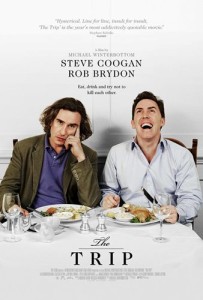
view/request
This feature mockumentary, edited down from a BBC television series, stars Steve Coogan and Rob Brydon as exaggerations of themselves in the entertaining fictional road movie, The Trip. The two colleagues continue their antagonistic relationship that began on the screen with Winterbottom’s A Cock and Bull Story. Coogan initially asks Mischa, his American girlfriend, to accompany him on an assignment where he’ll be writing a magazine piece covering restaurants and quaint inns in the northern English countryside. We soon learn the actor’s relationship is in trouble and he reluctantly calls on comedian Rob Brydon to join him.
What follows is a one upmanship contest of mythic proportions. The two bicker over their careers, public perception, height and general approach toward life. In the car and at various breakfast, brunch, lunch and dinner tables they battle it out with celebrity impersonations, vocal range and improvisational wars. The comedic competition is never ending, but never ceases to be funny. Contrasting the humor is Coogan’s desperation in private moments. Cell phone conversations (with a weak signal) to Mischa, his ex-wife, son and agent reveal the actor’s lonelier side and his frustration dealing with aging.
The uncredited supporting role of this film are the beautiful hills and mountains and the elaborate dishes Rob and Steve are served. Most importantly however, the friendship seen on screen, though obscured by Coogan’s condescension and bitterness, is rather touching at times. Despite his best efforts to isolate himself, this is possibly a story about meaningful human relationships.
Reviewed by Jason
Tagged: Comedy, Feature film, Food
Nilsson Sings Newman
by Harry Nilsson
[Music CD]
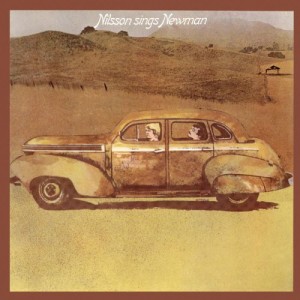
view/request
1970’s Nilsson Sings Newman is an example of the potential for beauty in popular music. Randy Newman, not then a household name, was approached by tenor extraordinaire Harry Nilsson about making an album. Nilsson was a fan of Newman’s effortless melodies, thoughtful chord structures and clever lyrical ability.
Nilsson Sings Newman features only the two artists in question. Newman composes the songs and handles the piano playing duties; Nilsson sings. The simplicity of this set up lends itself to display dynamics and emotive arrangements which do not seem to exist in most contemporary recordings.
Nilsson took great care in recording his vocals on the album. It is rumored that on some songs, pieces of 100 or so takes were spliced together (and remember this was using multitrack tape). He also layered his voice to produce heavenly, Beach Boys-esque harmonies in appropriate places. The refrain of the opener “Vine St.” or the sublime “Caroline” perfectly exemplify the richness of his harmony singing.
The album is full of story songs that in some places are nostalgic for the past. Lyrically, Nilsson Sings Newman feels like a truly American experience. Songs about cowboys, the Midwest and leaving home fill the record. As expected from Randy Newman, humor plays a large part as well. Nilsson, always a fan of silliness and inside jokes, contributes to the humor by insisting that certain off mic instructions by Newman be left on the final version.
Nilsson Sings Newman is an album that is graceful, funny and technologically impressive. It’s great on headphones and it’s one of those albums that I’ll never tire of listening.
Reviewed by Jason
Tagged: Pop music, Vocals
Where We Live: Steve Alves’ Western Massachusetts Film Collection
[DVD]
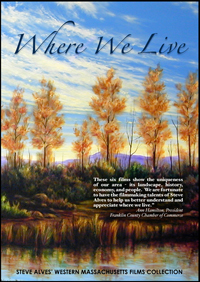
view/request
Filmmaker Steve Alves has been making movies about Franklin County since 1997. These six short documentaries were produced over a period of several years and explore the cultural, economic and natural world from the hyper-local point of view.
Titles: Beneath the River (about the Connecticut) — A Sweet Tradition (maple syrup production), Together in Time (contra dancing) — Everyone’s Business (local entrepreneurs and economic history) — Life After High School (jobs and education) — Talking To The Wall (Big Box sprawl vs. small town Main Street).
If you live here it’s hard not to be fascinated by the lives going on around us, both human and environmental. Steve really gets it, and he’s a fine director too. He is currently working on a new film called Food For Change. Watch for it!
Reviewed by Faith
Tagged: Documentary, Local history
The Rolling Stones: All 6 Ed Sullivan Shows
[DVD]
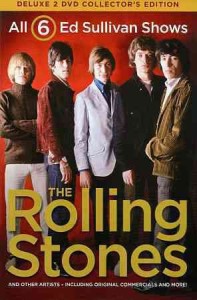
view/request
Recently added to the steadily-growing Forbes DVD collection is this wonderful 2 disc set I recently checked out. It has all of the Rolling Stones appearances on the Ed Sullivan show. From black and white to color television shows, the quality is the best I’ve seen so far and to watch the musical performances was a treat. An added feature is being able to select single acts or watch the complete show (vintage commercials included). Seeing early Rolling Stones, Dusty Springfield AND Tom Jones all on one evening’s show was a fun experience for me.
Reviewed by Susana
Tagged: 1960s, Rock music, TV shows

view/request
Film recommendations certainly play a role in a day’s work at the Arts & Music department. It’s often my favorite task to help someone find a film that fits their taste and am always flattered when a patron asks for me to select something that I enjoyed. Recently, the favor was reciprocated. A regular patron suggested, based on our many movie conversations, that I might enjoy the film Kes. He was correct and to continue the dialog, here’s my take:
Kes is a story that I consider the Northern England equivalent of Truffaut’s 400 Blows. Made a decade later, director Ken Loach, who certainly chooses not to glamorize youth or pander to children, creates a nearly bleak portrait of childhood. His central character, Billy Casper, lives in a poor, working class mining community and seems to have his future decided for him at 15 years of age. While not absolutely going for the heavy handed approach, Loach is suggesting flaws in, what he considers, the still existing English class system.
Billy eventually finds an escape from the constant bullying from adult figures (his headmaster, classmates, older brother, gym teacher, etc.) when he notices a nest on a neighbor’s property. He studies the science of training birds and eventually develops trust with a kestrel he appropriately christens “Kes”. His dedication and care earns him the respect from a group of classmates and a caring English teacher (who is possibly the only kind adult in the film).
Kes, which is heartbreaking and desolate feeling at times, is a remarkable work. Loach’s nonjudgmental camera style, the simple and lyrical imagery, the falconry scenes with young Billy’s textbook narration and soft English landscape gives the film a quality not unlike a documentary.
Reviewed by Jason
Tagged: British film, Drama, Falconry, Feature film
The Penny Whistle Book
by Robin Williamson
[Book]
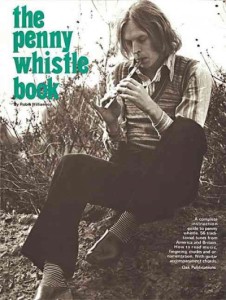
view/request
A couple months ago, I saw The Penny Whistle Book come up to the Arts & Music library and happened to notice that it was penned by the Incredible String Band’s Robin Williamson. He was essentially one half of the group, sharing vocal and songwriting duties with Mike Heron. At this time I also was thinking about the arrangement for a song of my own and was in need to have a flute or whistle type sound for a two note hook in the final chorus (a la “Penny Lane”).
The sensible thing to do I thought was to go to check out the book and head to
Downtown Sounds in Northampton and see how much one of these whistles costs… Turns out they’re very cheap (something like $10). I cracked the book open, read the introduction and was making sounds and playing scales right away.
The slim Penny Whistle Book is filled with traditional American and British tunes with accompanying illustrations that reference the era in which the pieces were most likely composed. The sheet music is also perfect for playing instrumental accompaniment like guitar or banjo because chords are placed at the top of the staffs.
The penny whistle is a fun and simple instrument to play. You really don’t need to be able to read musical notation or have special technique in operating a mouthpiece. You just place your fingers on the holes and blow!
Reviewed by Jason
Tagged: Folk music, How to, Music instruction
Hindugrass
by John Heitzenrater, Carolyn Balfe, Yunior Terr, Evan Fraser, and Austin Wrinkle
[Music CD]
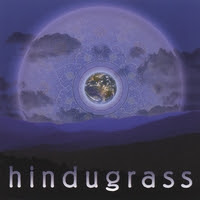
view/request
What could you find in common between the classical and folk music of Northern India, and old time and bluegrass music of the Southeastern United States? Quite a lot actually, and Hindugrass does an excellent job exploring and exploiting those similarities. Headed by John Heitzenrater on sarod, Hindugrass is alternatively haunting and driving, lyrical and percussive, familiar and strange. In addition to sarod we hear, fiddle (played in American style), bass, tabla, kanjira, bones, and other percussive instruments. The melodies comfortably shifts back and forth between a more eastern and a more western sound, but the rhythms show a primarily Indian influence, with the melodic and percussive instruments alike taking part in the polyrhythm, tihai, and other rhythmic devices that are responsible for much of the excitement of Indian music. This is an exciting recording for lovers of Appalachian and Indian music alike. You can get a preview of their music at http://www.hindugrass.net/, or borrow the CD from the library to hear the whole thing!
Reviewed by Ben
Tagged: Folk music, Indian music, World music
Page One: Inside the New York Times
by Andrew Rossi
[DVD]

view/request
Andrew Rossi’s film Page One explores the role of print media in a rapidly changing technological landscape. The documentary goes inside the Eighth Avenue tower and we watch events unfold and become shaped into articles that eventually get delivered to our doorsteps.
The Internet has redirected the way in which many people seek information and this proves to be a financial threat to the survival of every newspaper. When Julian Assange’s initial YouTube barrage is dropped on the heads of the public, the Times writers not only have to think how to cover the event, they also need to ponder how it affects journalism on the whole. The WikiLeaks organization may upload footage, reach millions of people in a matter or moments and have little accountability in how they present their broadcast. The Times realizes that though they must follow the guidelines of responsible reporting, they still need to compete with this brand of information giving on some level.
Staff members are also profiled and followed around through the course of pitching and working on articles. We go inside meetings and presentations, too. David Carr, arguably the star of this film, is seen laying down the law in a meeting with Vice personnel, seeing his elderly father and giving a presentation on technology and media. Carr and many of the staff on screen, discuss the role of technology and Twitter and other social media.
Though the advertising and subscriptions that power the New York Times are at all time lows, the paper continues to move forward. Page One documents this tense, transitional period and shows the organization working on the fly to stay in the business.
Reviewed by Jason
Tagged: Documentary, Journalism, Technology
Talking heads Chronology
[DVD]
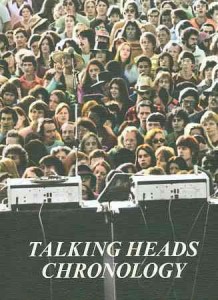
view/request
An official retrospective DVD compilation of rare footage and performances from throughout the Talking Heads illustrious career. The footage spans chronologically from mic tests and rough 1976 black and white footage of the band in NYC to television and festival performances during the height of their fame in the early 80’s. As the quality of the footage improves, the band becomes tighter and more assured, adding members until it culminates in the art-house funk monster period of Remain in Light and Speaking in Tongues. This development and gradual expansion of the band in style and number mirrors the sequences of Stop Making Sense, the bands epic masterpiece concert film, but also allows a rare live glimpse of the late 70’s Heads whose angular tightly structured charm was just as innovative for its time as their later afro-cuban funk explorations. Talking Heads fans have waited for years without any significant “archived material” from the band and few releases outside of greatest hits compilations, and this release provides the perfect companion to Jonathan Demme’s 1983 concert film. The DVD is bound within a book with some great photographs of the band and extensive liner notes by Lester Bangs, who lets loose with his usual unrestrained hyperbolic blurt.
Reviewed by Dylan
Tagged: Documentary, Live recordings, Rock music












